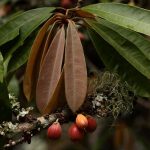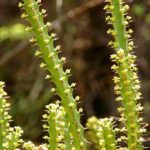TREE LIFE
August 1983
MASHONALAND CALENDAR
Saturday August 6th : Botanic Garden Walk. Meet in the Car park at 1045 for 1100 hours.
Sunday August 21st : Ivordale Farm, Enterprise Area. Meg Coates Palgrave has done a recce of the area and we are promised an interesting outing. A bus has been booked from Harare and will leave from Monomatapa at 0900 hours. Fare $5.50.
BOTANIC GARDEN WALK JULY 2ND 1983
As I was freezing in Bulawayo I am indebted to Meg for both her notes on the walk, and showing us the specimens seen. The family SAPINDACEAE is in fact a difficult one to tie together on vegetative characteristics. Having seen the genera and consulted the tomes we are only now developing a feel for this diverse family. In theory the family is divided into two groups, the lianes and the trees or shrubs. It was thus exciting to examine the creeping Paulinia pinnata from a theoretical point of view as the lianes are the only truly imparipinnate SAPINDACEAE, none of the trees and shrubs are allowed to have a true terminal leaflet, although they may appear to have developed one either by abortion, or by rotating one of the last pair into a position where it appears to be terminal. In either case the end product should appear asymmetric. Paulinia is a typical SAPINDACEAE liane which all climb by tendrils (metamorphosed inflorescence axes) which are usually branched and sometimes like a watch spring. The lianes may have stipules. A SAPINDACEAE feature which we were to see again in three other genera was the distinctively winged petioles.
Unfortunately not all SAPINDACEAE have compound leaves. Pappea (Rhodes’ Indaba Tree) and Dodonea are simple leaved. In common with all non liane SAPINDACEAE they have alternate leaves without stipules and the sexes are on separate trees. SAPINDACEAE fruits are generally of an unusual shape and colour, but are often red and the seed may be surrounded by an aril. Juvenile Pappea capensis have closely toothed leaves in contrast adult trees have entire leaves with an oblong shape and leathery texture (just look at late 167 of Coates Palgrave to see an unusual SAPINDACEAE fruit). The well known Dodonea viscosa has erect leaves that may flush red in spring, yet another family feature. The Combretum-like fruits have only 2 or 3 red wings. In the Cape Dodonea grows in a thick belt on the boundary between the Karroo shales and the Table Mountain Sandstone and as such it is a useful indicator species to tell us when one is crossing into or out of fynbos vegetation.
With these few exceptions SAPINDACEAE are usually pinnately once-compound as is illustrated in the genus Zanha. Both local species have our tree society “spot” – the distinctive “ball and claw” bud. Zanha africana which is common on granite kopjes around Harare has hairs on the fruit and mature leaves whereas Zanha golungensis, occurring in dry forests in the eastern districts, lacks these hairs. There was that memorable outing to Shamva where we examined a large Z. golungensis not far from the road. Although paripinnate it was exciting to see how many leaves appeared to have the SAPINDACEAE “terminal” leaflet by rotation.
I remember being amazed at Jill Masterson’s recollection of Haplocoelum foliolosum on the Watkin’s farm, Chegutu, a plant she had seen many years previously. The small square leaflets which resemble Albizia gummifera are borne on a SAPINDACEAE winged rachis. Yet another family feature commented upon on the walk was the largest leaflet at the top, well illustrated in this specimen.
In the forest section near the Paulinia are some fine specimens of the riverine tree Aporrhiza nitida with a distinctively fluted trunk and horizontal white streaks on the bark. Tom proposed the swollen petioles may distinguish this family from the MELIACEAE. Right alongside Aporrhiza is Blighia unijugata with an identical trunk and similar false terminal leaflets. We were excited to find hairy pockets in the vein axils, an indication of the relationship to Allophyllus. Once again the swollen petiolules, larger end leaflets and the red juvenile flush. B. unijugata is a medium height tree common on the burial grounds near Mt. Selinda down through Mozambique where it can be a giant in coastal forest.
Two more eastern dry forest species, Glennia africana has such a marked leaflet size variation that the base leaflets are small and round. The only surviving seedling Tom was able to find was so small it still had simple leaves.
An even rarer tree, Pancovia golungensis was in fact the first tree examined on the walk. It occurs in Natal and Mozambique although one specimen is recorded from Burma Valley. The thin textured leaflets are carried on swollen petiolules and flush out red.
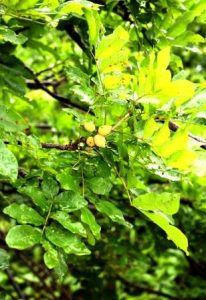
Lecaniodiscus fraxinifolius. Photo: Bart Wursten. Source: Flora of Zimbabwe
Lecaniodiscus fraxinifolius was another specimen with pinnate leaves and although the leaflet margins are very wavy they are in fact entire. A lowveld riverine and Zambezi alluvium tree that Meg and Paul called the river litchi due to its strange fruit. Stadmania oppositifolia occurs where the water supply is increased either on hilltops, where rocks form underground reservoirs or along rivers like the Umvumvuvu. The soap berry, Deinbollia xanthocarpa is another alternate pinnate leaved SAPINDACEAE although the specimen examined his its leaves on the end of a slender 3 to 4 m stem so we were unable to see the leaf detail.
An exciting tree for family characteristics is Filicium decipiens, one of the few forest specimens with a rough bark and the biggest of the SAPINDACEAE in Zimbabwe. As the name implies the leaves are ‘deceptively fern like’ with a marked winged rachis, distinctly false terminal leaflet and a swelling at the petiole base. This tree is found in isolated forests and in the Burma Valley often associated with Newtonia. A similar lanceolate leaflet occurs on the small leaved Erythrophysa transvaalensis, now found to be quite common around Bulawayo. Being deciduous it had only a few dried leaflets left. It can become a bush 2 to 3 m high with a winged rachis, an unusual feature in Matabeleland vegetation.
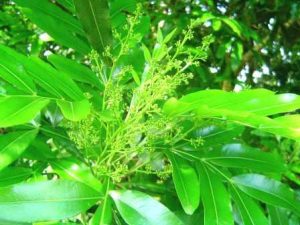
Filicium decipiens. Photo: Bart Wursten. Source: Flora of Zimbabwe
The final genus deserves a special note. Allophylus seems to break the rules so it would be interesting to keep an eye on it in future. The trifoliate character appears to display a terminal leaflet, although we were able to note a distinct asymmetry, with the ‘terminal’ leaflet often so offset that it overlapped a side leaflet quite markedly – we must compare this with Rhus, ANACARDIACEAE. Secondly according to Coates Palgrave (1977), Allophylus is bisexual; Willis though states all SAPINDACEAE are unisexual although in some, the “stamens are often so well developed in the female flower that it is easily mistaken for bisexual but the pollen is useless and anthers don’t open”- any comment? Tom showed us four species. Both A. chaunostachys which occurs below Mt. Selinda and the lowveld riverine species, A. alnifolius, have a SAPINDACEAE red fruit. A. abyssinicus may grow into a big tree in the drier eastern forests such as Mtarazi Falls View, and it occurs at the first tee of Leopard Rock Golf Course. Our local granite kopje species A. africanus which rarely becomes more than a big bush was in its deciduous yellow leaf.
After all this, the SAPINDACEAE do hold together as a group; thank you Tom Muller and Meg – I realize how invaluable these walks really are.
-Kim ST.J.Damstra
VISIT TO PALM BLOCK, SUNDAY 17TH JULY 1983
Our bus left Harare promptly at 0800 hours heading for Palm Block. We stopped briefly at the miserably low waters of Mazowe Dam for members to buy oranges and also at the Hotel to pick up the Mt. Hampden and Mazowe contingents. We arrived soon after 1000 hours and were happy to find the Ayrshire contingent and Bindura members had already arrived.
After a brief map orientation from the Chairman, the party set off without further ado from the picnic area to explore the palms. I don’t think a single person present failed to be impressed by the size of these relics of primordial aeons. When standing in the thick of them one half expects a dinosaur to come crashing past or a pterosaur to swoop through the enormous fronds.
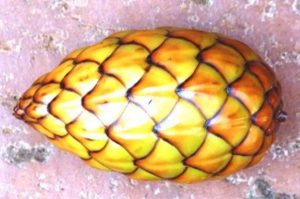
Raphia farinifera seed. Photo: Rhett Butler. Source: Flora of Zimbabwe
These palms are currently labeled Raphia farinifera. In 1968 the late Joseph Ritchken wrote in Science News that this is the most widespread of seven African Raphia species. It also occurs in Madagascar. He says that the stem can be 30 ft. high. Add to that a leaf of 60 ft and it is then no surprise that we saw such huge palms. Some specimens were fruiting and members were able to examine the ovoid fruit covered in scales of a rich polished mahogany – orange hue. The palms are doomed to wither and die once they have fruited, according to various sources, including Palms of the World.
The general view was that there was good regeneration of palms. Previous visits had given rise to some concern in this regard. The palms really spoke for themselves, but for more interesting information, history and background I do recommend Dr. Ritchken’s article in Vol. 2, No. 9, September 1968 Science News which includes an extract from the late Douglas Aylen’s 1968 Newsletter.
There were plenty of other botanical treats to delight the eye, first of which was perhaps Nuxia oppositifolia with opposite leaves with serrated edges. They were in flower, much to our delight. On our way up the road we passed a sizeable specimen of Securidaca longepedunculata. This had caused considerable confusion even amongst the academics due to the powdery and peeling bark on the trunk and older branches, whereas the “bible” describes the bark as light grey and smooth. Dick Petheram resolved the confusion by informing us that the bark goes like this if fire damaged. He also showed us a good test for S. pedunculata. If a branchlet is picked and the bark peeled, it “strips” all the way to the tip.
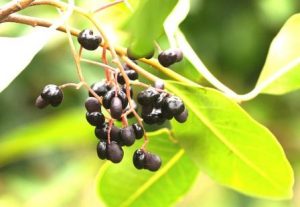
Apodytes dimidiata. Photo: Bart Wursten. Source: Flora of Zimbabwe
We then saw the not often seen Olinia vanguerioides with its very characteristically flaking bark. Even the smallest branchlets flake. Close by we saw the first of many Apodytes dimidiata which, like Olinia, has pink petioles. In Apodytes however, the pink of the petiole extends onto the midrib of the leaf. The upper surface of the leaf is a dark glossy green with a duller and paler under surface. The leaf margin tends to be wavy. Leaves are alternate while in Olinia they are opposite.
As a small tree or shrubby scrambler we soon encountered masses of Carissa edulis. We noted the opposite leaves coupled with the paired straight thorns. Many were in fruit, which when mature are purple black fleshy spheres about a cm in diameter. The juice inside is white mingled with purple and quite tasty.
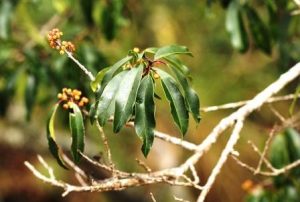
Ilex mitis, Photo: Bart Wursten. Source: Flora of Zimbabwe
Very prominent in the understory were Bequaertiodendron magalismontanum and Ilex mitis, the Zimbabwean sibling of the European holly. The spikes on the leaf margin so characteristic of the true holly do occasionally appear on the local version and we did see some. Kim proved Bob Drummond’s “test” of this plant. If one crushes up the leaf and rubs it vigorously between one’s hands with water, as with soap, then a bright yellow lather develops. It worked very well. Whether Kim’s hands were any cleaner after this exercise, I don’t know.
Far from its more normal habitat in the Eastern Highlands, we found Cussonia spicata. Unlike C. arborea the more common Highveld Cussonia this has upright flower stalks like a candelabra while those of C. arborea look more like a spindly octopus. The leaves of C. arborea are straight forward palmately compound, while in C. spicata they may be said to be bi-palmately compound with a very prominently winged rachilla – i.e. the rachis on a leaflet.
Also very common on the forest margins was Maesa lanceolata. Those we saw showed great variation in leaf size. Some very small and some which would have been good fig leaf substitutes in the Garden of Eden.
Venturing out beyond the forest to the barer slopes of the Dyke we came across plenty of mineral resistant Diplorhynchus condylocarpon. More exciting perhaps were some good specimens of Protea petiolaris which is another tree more common to the Eastern Highlands, and also seen at Wedza mountain. The narrow petiole like leaf base gives the leaf a rather droopy appearance. The leaves we saw were perhaps not as sickle shaped as some of the literature would have us believe.
Also growing outside the forest on the lower slopes of the Dyke, and which I find exciting every time I see it, was Ozoroa longipetiolata, which is endemic to the northern Dyke. This is distinguishable from the common woodland O. insignis by its much longer petiole and the pale under surface of the leaf.
After lunch at the picnic area we travelled through Gurungwe gap with a view of the Horseshoe Dyke and south to Birkdale pass. En route, by courtesy of Benedicta Graves we were able to examine prepared wood specimens of Kirkia acuminata, Diplorhynchus condylocarpon, Protea petiolaris and Faurea saligna, the latter two bearing a striking resemblance to each other, both being of the family PROTEACEAE.
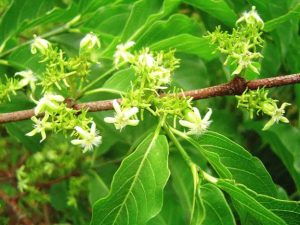
Vangueria apiculata. Photo: Bart Wursten. Source: Flora of Zimbabwe
Along the stream running through Birkdale pass the first item of interest seen was Vangueria apiculata, again more common in the Eastern Highlands. This has a glossier and brighter green leaf than the more frequently encountered V. infausta. Having earlier seen a large concentration of raffias it was now interesting to see a concentration of Phoenix reclinata, some of which were in full fruit. Plenty of Apodytes and Maesa were also seen at this pass together with large Syzygium specimens.
The Dyke slopes above the pass yielded another Securidaca longepedunculata, this time with more conventional bark. At ankle level Margaret Meakin spotted another Dyke endemic which was Rhus wildii and despite its dwarf size this still demonstrated the typically trifoliate leaves and flattened square fruits of Rhus. Another ankle high resident of the Dyke was spotted by Anton Ellert. This was a pink flowered Crytanthus thornicroftii. This belongs to family AMARYLLIDACEAE along with Haemanthus and and Boephane.
From this spot the gathering split up enabling the Harare bus to get home just after dusk. A good day was had by all I believe!
-J.P.Haxen
MATABELELAND NOTES
Sunday August 7th : Mabukaweni. Meet there at 0830 hours.
Sunday September 4th : Hillside Dams. Meet at the Upper Dam at 0830 hours.
Our planned outing to the Matopos fell on a cold, rainy day in July with a biting wind, so we were deprived of the company of two members from Fort Rixon as well as several local members. It was a great pleasure to have with us Phil, Cheryl and a bundled up baby Jessica Haxen, and Kim Damstra, three and a bit members from Harare. We were pleasantly surprised to find the Matopos not only drier than Bulawayo but slightly less chilly so we were able to have a full and very interesting day. I will refrain from naming trees seen, leaving this to the Hararians to record what they thought of special interest, so over to them.
-D. Webb
Thank you, Dora. This is one place I really feel the increased printing costs and regrettable need for brevity as we were shown so many exciting trees and experienced that impressive charm unique to the Matopos. Despite the weather, we were warmed by the enthusiasm and patient teaching of the delightful little group, and did they know the trees! In the shadow of an enormous granite boulder we were shown Strychnos matopensis, an endemic scrambler with curling tendrils and fresh green leaves with the characteristic Strychnos veination. Cheryl predictably began her Eve-imitation and ate the ripe fruits. As she failed to fall down dead we all followed, experiencing the refreshing taste. At last I was shown a real live Acokanthera schimperi with its poisonous APOCYNACEAE milk and round, dark shiny green leaves. So the dried truncheon so excitedly flown back from Bulawayo on Phil’s last trip can now cease to ornament our house.
We were all impressed by an enormous Schrebera alata, where I learned that the large wooden pear we collected at the Logan’s farm, Shamva, was not S. alata, but the simple leaved S. trichoclada. S. alata has a less woody, small fruit encasing winged seeds. A further new item was a real toilet paper leaf, the abrasive Cordia grandicalyx. Around the side of a nearby rock we were shown Brachylaena rotundata where the dark green leaves are thickly coated in a matted cobweb which so often exists in the ASTERACEAE (ex COMPOSITAE) and is thought to help withstand desiccating conditions. As a result it is a common feature in exposed coastal and desert vegetation.
All Ochna species have an indescribable but characteristic venation and elongate bud that we saw so markedly on a bushy tree with small, blue-grey leaves which occurred above the rocks on which we ate our sumptuous lunch. This little species, Ochna glauca is locally common south of Bulawayo. Looking over the side of the same boulder we found Tarenna zimbabwensis, ex Enterospermum rhodesiacum, and it is good to see it now in the same genus as I. neurophylla as the leaves have a similar fountaining droop, although they are much broader. Alongside it was the light green flush of Trema orientalia with leaves 3-veined from the base but evenly serrated along the margin.
Moving on it was really exciting to find Artabotrys brachypetalus at the Lower Outspan. A plant I have been repeatedly shown in captivity, but never seen in the bush. This plant has incredible flower stalks that hook over the branches of neighbouring trees and support the tree. It is a pleasure to see that ANNONACEAE feature, the way all leaves are held out in a flat plane on the branch. Later in the day we were to see another ANNONACEAE, Hexalobus monopetalus, but this time the variety monopetalus with narrower leaves than the variety obovatus we saw last month at Reoch Farm, Chegutu.
As we made our way up the Gun Carriage Track we saw two species of paper bark alongside each other; Albizia tanganyicensis of the family FABACEAE, ex LEGUMINOSAE, with smooth opalescent under bark and red papery peels. A distinctly sensuous tree that has an exciting feel. And then, belonging to the entirely unrelated family the BURSERACEAE, is Commiphora marlothii, with an identical bark, although in yellow.
We surely regretted having said good bye to the Bulawayo folk when we discovered a mystery tree on the way to World View, a specimen in old fruit with obliquely rectangular paripinnate leaflets. We went back to the evening drawing board to discover the sneezewood, Ptaeroxylon obliquum, the only local tree in the PTAEROXYLACEAE. (Identification would have been quicker had it fallen with the aromatic leaves in Coates Palgrave key on page 34, character 2). A final thanks to the Bulawayo branch for a truly memorable day.
-Phil Haxen
ROOT NOTES While Margaret was in the public library I strolled over to a small group of trees opposite the entrance to the school of music. We planted these trees in October 1979 as part of the Jacaranda Festival. A pink jacaranda, Stereospermum kunthianum was planted by the lovely young ‘Jacaranda Queen’. Other trees were planted by the mayor, Councillor Jack Whiting, Mr. Boots Harding, ladies of the Lochinvar Women’s Clubs and pupils from Lochinvar schools. Seedling were supplied by Anton Ellert and holes were dug and composted by Parks Department. It was a very happy occasion and I recall one of the dignitaries boldly suggested we christen it the Mutsa Forest (MUTSA = kindness, favour, humanity).
The trees have shown impressive growth during the past 4 yrs. The Khaya nyasica, Chirinda’s big tree, is 10 meters and despite this year’s drought was topped by a vivid splash of new red growth. Acacia polyacantha is over 6 meters and the Syzygium cordatum, Ficus capensis and Celtis africana are all well up. The tree planted by the Queen is not very tall and Anton now thinks the seed may have been mixed up with a yellow jacaranda, Markhamia. Strangely the two Highveld plants, the musasa and munhondo perished after the first season, possibly by council mowing machine. The rapid growth of the others, though, shows how false it is to assume that indigenous trees grow slowly. The parks department are looking after the trees well but possibly I could suggest that the Harare Publicity Association, who were instrumental in planting the trees, could put up a plaque naming the trees and explaining their presence, a valuable contribution to conservation education.
-G.HALL
ROOT NOTES Yet another lesson from Binga Swamp Forest: one of the offensive weeds is commonly called seringa, a name for which I was severely chastised at Wits Herbarium earlier this year as this tree Melia azedarach, also called Persian lilac or Indian lilac, belongs to the family MELIACEAE and bears no resemblance to what the British call seringa, the mock orange. I hear from Bob Drummond that even the Brits are wrong, as the mock orange which can be found planted, at Eagle School in the Vumba is Philadephus coronaries and belongs to the family HYDRANGEACEAE. The genuine Syringa vulgaris is the lilac which grows in south-east Europe and belongs to the OLEACEAE. It just proves the problems that arise from common names and the need for standardization. Further complications arise in Zimbabwe, where we also have the white syringa, Kirkia acuminata, family SIMAROUBACEAE, a whole collection of totally unrelated plants.
Janet Webber writes from East London that in a TV programme by Andrew Tracey on his marimbas he states he uses the wood of the sneezewood, Ptaeroxylon obliquum for the keys. Here in Matabeleland Olaf axelsson who also makes marimba uses Pterocarpus angolensis.
MUKUVISI WOODLAND VILLAGE WOODLOT AND AGRO-FORESTRY DEMONSTRATION
In mid 1982 we were offered US$1 000 by Environmental Centre in Nairobi to spend on an afforestation project involving renewable resources.
It so happened that as part of its overall planning the Mukuvisi Woodland Association was projecting a village woodlot demonstration in the north west corner of the Woodland area, so the Tree Society and the Association joined together to work on this project, thus funded in modest proportions by the Nairobi people.
INTRODUCTION
Since the mid seventies the Tree Society of Zimbabwe has taken part in many discussions and meetings with many people and organizations about the fuel wood problem.
Perhaps because of our prime interest in the native flora of this country we have been among the small band of people who have pointed out that, properly managed, natural woodland can be efficiently cropped for fuel wood, fencing, construction materials etc.
As a mere amateur society we have grown used to our views being rather scorned by the professionals who never fail to point out the differential in growth statistics between Eucalyptus and Brachystegia, effectively ignoring the fact that the Musasa is not the sole economically valuable indigenous tree.
In 1976, rather fed up with all talk and no action, in our own small way we started our first experimental work results of which can be seen today by anyone interested.
This initial work showed us that further experimentation was fully justified, and we produced one very important fact and that was, in the greater Harare environment, it was the naturalized exotics, Melia Cedrella, Jacaranda, Bauhinia, growing in ‘natural’ woodland, that produced the greatest volume of produce in the shortest time, and that such was the generation potential of these plants that the same individual could be cropped more or less continuously. How long an individual root system will allow itself to be continually cropped for fuel wood awaits really long term experimentation.
We did not therefore start the current work from point zero, the experience gained in the preceding decade was invaluable.
METHODS
INITIAL CLEARANCE
The land available to us was the rather extended triangle running south from the caretaker’s cottage, bounded on the west by Glenara Avenue, and on the east by a vague boundary which will ultimately be determined when the plans for the future interpretive services centre is built, and in the south the woodlot demonstration zone tapers to a point on the right side of the Chiraura Dam.
We started work in September 1982 and the first step was to cut the previous season grass and at the same time start thinning existing fire induced thicket growth of Melia and Jacaranda.
At this stage we also thinned a number of more mature individuals, Jacaranda and a few Melia which up to 20 years of age had developed up to 4 and 5 separate trunks of 10cm or more diameter. These we thinned down to one or two trunks.
From this initial clearance we corded up 5 cubic meters of fuelwood
PLANNING
Having cleared the ground we could now see what we were working with, and by rather rough measurement on the ground estimated that we were using approximately 3 ha of land, and bearing in mind our slender resources of finance we accepted that we would not deal with the whole project area in the first year.
Accordingly we divided the upper two thirds, approx, of the land into 11 plots, marking the boundaries with brush wood, grass etc., i.e. to produce of the initial clearance.
We then classified the area into three types of usage :
- Plantation with Eucalyptus
- Cultivation in keeping with the principles of agro forestry
- Sustained yield production of the existing woody vegetation
For reference the plots thus allocated were :
- Eucalyptus plantation : numbers 3, 4 and 8; area approx .6 ha
- Agro-forestry : numbers 1, 2 and 5; area approx 0.5 ha
- Sustained yield on natural regeneration : numbers 6, 7, 9 10 and 11; area approx 0.8 ha
At this stage we found it expedient to cut out some more Melia and Jacaranda on plots 2 and 3 thus producing a further 2 cubic meters of fuel wood.
WORK ON AGRO-FORESTRY PLOTS :
In September we established a sweet potato nursery of approx 60 square meters to service a sweet potato garden to be planted out with the onset of the main rains.
The soil here was not really ideal for this crop, being too free draining, but the site selected was downhill from the main storage and service area of the wood land and we envisaged trapping the run-off from here and channeling it into the sweet potato section.
The site of the sweet potato section was also in an area with fairly heavy Brachystegia and Ficus canopy growth and previous experiments had shown that this crop could be grown successfully beneath such a canopy.
Concurrent with the November rains we commenced cultivation of plot 1 for maize. As these November rains were not sustained we planted nothing. When more rain fell in the second week of December we planted about 500 square meters before it became apparent that these were not ‘planting’ rains.
When it was apparent that the planting rain was not going to come we abandoned planting with maize and the small area sown became a complete failure even though some hand watering was attempted.
Because of drought therefore the year’s agro forestry demonstration was a complete failure.
EUCALYPTUS PLANTATION
For reasons of drought the Eucalyptus plantation was by and large also a complete failure.
With the onset of the rain in December we planted 150 Eucalyptus grandis which just covered plot 4. We planted these at spacing of 3 m each way and followed the specifications for planting and preparation as laid down in ‘Tree Planting in Africa South of the Sahara” published by the Environmental Liaison Centre, with the exception that we did not stump the whole area as our modest finances did not permit this.
To compensate for the lack of stumping we made the spacing wider and were prepared to water during the first dry season.
No rain fell on this plot for six weeks after planting and by 24th December we commenced watering. Good soaking rain fell in the last week of January, but not before we had lost 35 plants, i.e. 25% from drought stress.
The good rains were not maintained and as a result further heavy losses continued. In early April periodic watering of the survivors commenced in an attempt at least to keep a few individuals alive.
At 1st May less than 50 individuals were still alive and despite the re-commencement of watering mortality was still occurring.
The severe drought notwithstanding, other factors were involved in the heavy mortality and a detailed analysis is included herewith as an appendix.
SUSTAINED YIELD PRODUCTION OF NATURAL RE-GROWTH
Faced with the complete failure of the first two sections it is pleasing to be able to say that in this section the results are very good. Far from re-generation suffering at all from drought rule of thumb observation suggested that the lack of real rain before the end of January inhibiting the growth of grass, as it did, possibly assisted the woody regeneration by allowing the latter to take up more nutrients from the surface soil. The growth of Melia and Jacaranda was so explosive at the time that I have largely discounted these species from my rule of thumb conclusions, these two species enjoying alien vigour, as they do, are not so easy to gauge. It was the good growth of Julbernardia, Ekebergia growing in communities and a few other species such as Acacia and Azanza growing as individuals, which took my attention.
The main work on this section comprised of a) thinning regeneration down to a manageable number of stems and b) thinning existing mature trees and in some cases removing same, where required, to make room for future development.
a) Was a very simple task, done mostly by the supervisor whilst organizing work or inspecting same, and exception to this was the clearance of plot 6, which is a 100% stand of Melia azedarach.
b) Was a more time consuming exercise, and consisted in the main of cutting out further excess Melia and Jacaranda trunks of over 30cm diameter and also the removal of two mature Eucalyptus. Further fuel wood and usable poles were harvested here bringing a total of 12 cubic meters the amount of fuel wood harvested in the first four months of the experiment.
The market value of the mixed type of fuel wood we are producing is $6 per cubic meter, therefore the value of our production in the first 4 months was $72. To time of writing sales of fuel wood amount to $20.
No attempt has been made to effectively measure re-growth over the whole experiment; however groups of individuals were recorded to give some indication. Melia and Jacaranda regeneration from ground level started in September concurrent with our first work on the ground. Within 2 months this re-growth had reached 1 meter in height. Within 4 months approximately 50% of individuals recorded had reached 2 meters and bore proper woody bark systems. By 8 months approximately 25% of the original individuals recorded had reached 3 meters and a stem width at ground level plus 25cm of 3 to 4 cm.
Not benefiting from exotic vigour the Brachystegia/Julbernardia regeneration on plot 10 had gone in some cases from 50cm in September to 2 meters in 8 months, most leveled off at between 1 meter and 1.5 meters.
Estimates show that as at 1st May 1983 a further 8 cubic meters of presently standing fuel wood could be cut without lessening future yield on a sustained basis. There is no point in doing this work now in the absence of a ready market for what is already cut and on the ground.
SUMMARY
The poor year from a rainfall aspect has meant complete failure in regard to the Eucalyptus plantation and the agro-forestry plots. However, the good showing in regard to the sustained yield plots very definitely shows the value of this experiment and the value attached to continuing it next year.
-George Hall, May 1983.


